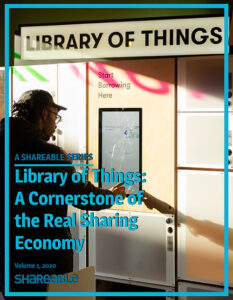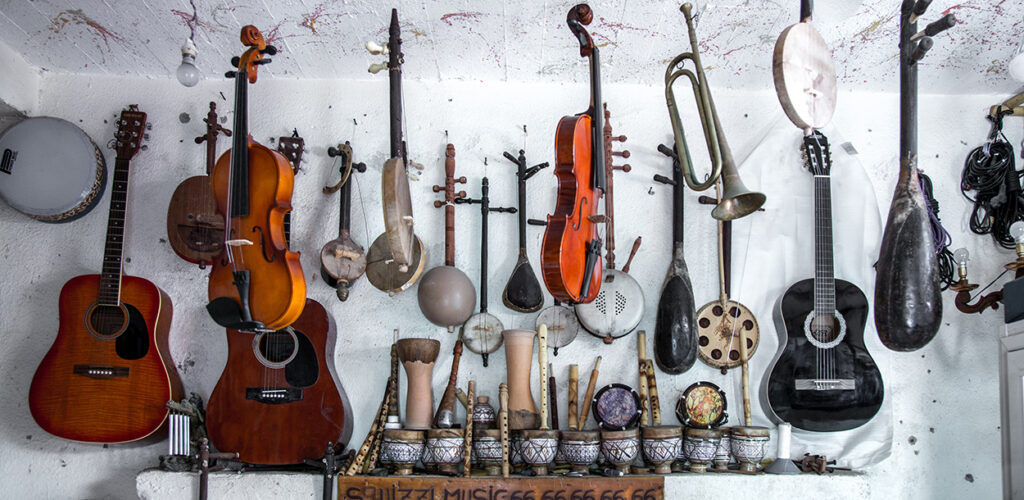In 2017, 59 percent of public libraries in Ontario, Canada reported having non-traditional circulating library collections (e.g., fishing gear, recreation equipment, musical instruments, seed gardens etc.). According to the Federation of Ontario Public Libraries, the most commonly available items for check-out are: seeds, fishing gear, energy monitors, museum/art gallery passes and pedometers.
Throughout North America — and beyond — public libraries have quietly become the places to share whatever it may be that people wish to share in a non-monetized context. Katarina Michnik and Catarina Eriksson report how, in some Swedish public libraries, you can now check out bikes, bicycle helmets, bike pumps, fitness equipment and other “tools that facilitate active pastimes.”
This activity typically emerges at the grassroots, with local partners coming together to utilize the infrastructure of the public library to share resources, skills and space. In the United States, approximately 96 percent of the population lives within a public library service area, and about half of U.S. libraries are located in small towns and rural areas. This social infrastructure is extremely decentralized, with nearly 90 percent of library funding coming from municipal or county sources.
In December 2019, Jennifer Johnson of the Vermont Department of Libraries asked members of the Vermont Libraries listserv to complete a form indicating what “non-traditional” objects are available at their libraries for check-out. The results, which are publicly accessible, testify to the heterogeneity of this trend.
The 56 public libraries in Vermont that indicated they have non-traditional collections circulate everything from a Batgirl costume (Cutler Memorial Library) to ski passes to the Snow Bowl and Rikert Nordic Center (Ilsley Public Library) to a 12-foot tree pruner (Winooski Memorial Library). Through a partnership with the Vermont Department of Health, 47 public libraries also check out snowshoes.
The phenomenon also extends beyond objects. The latest trend in public librarianship focuses on how libraries can share their spaces. The Robert Wood Johnson Foundation reports that, in Monterey Park, California, “Line dance leader Kit Cheung teaches her class of Chinese-American women in an unlikely place — the parking lot of a local library. No other public location offers both the outdoor space and sun cover the group requires for their twist on the traditional Chinese exercise of tai chi.”
City librarian Norma Arvizu states, “There was a concern for me in the beginning because they would interrupt the flow of folks coming through. Later on I realized that this would be a positive image for the library, because these are residents. These are actual people that live here. Why were we not allowing them to use what their taxes pay for?”
Similar attitudes to sharing of public space emerge across the country. In Bellingham, Washington, the public library removed two rows of shelving to create a SkillShare space. The mission of this space is to “bring people together to share and learn.” Anyone can share their skills in this space, and popular activities have included ukulele lessons, tai chi sessions, arts and crafts, chess and other games, all led by local residents.
National data also backs up these trends. A study commissioned by the American Library Association in 2018 found substantially more voters said they think libraries should provide “activities and entertainment not found elsewhere” in a community (48 percent, up from 38 percent in 2008), and more think libraries should be “a place for people to gather and socialize” (45 percent, up from 36 percent in 2008).
In my research in North Carolina, I’ve found this approach to sharing public space in both rural and urban communities. Libraries in cities like Durham and Chapel Hill, and in rural areas like Hendersonville, all have forms on their websites that anyone can fill out to propose a collaboration focused on sharing skills and knowledge at the library.
All this activity continues during the COVID-19 pandemic. Everywhere from Salt Lake City to small-town West Virginia, public libraries have continued seed-sharing with their communities. Patrons can request their seeds online and librarians send them out via the USPS. To facilitate the sharing of virtual space, Pennsylvania’s Schlow Centre Region Library invites community members to Reserve a Virtual Community Room. Here’s how it works:
“Schlow now has seven Zoom rooms available for groups, organizations, and businesses to use for free. The digital rooms can accommodate a maximum of 300 people and be reserved for up to two hours, Monday through Friday between 9 a.m. to noon or 4 to 7 p.m. Groups can reserve a Zoom room for a maximum of two meetings per month.”
Every public library is unique, so it is probable that not all of these services are available at your local library. However, the take-away from these facts are as follows:
- Public libraries wish to maximize their resources to promote sharing of skills, knowledge and resources in local communities;
- They have already started this work, but could do more with your participation;
- If you want to promote sharing in your community, and have not yet reached out to your local library, you are “leaving money on the table.”
##
 |
This post is part of our 2020 editorial series on libraries of things. Download the free ebook from the series here. |









